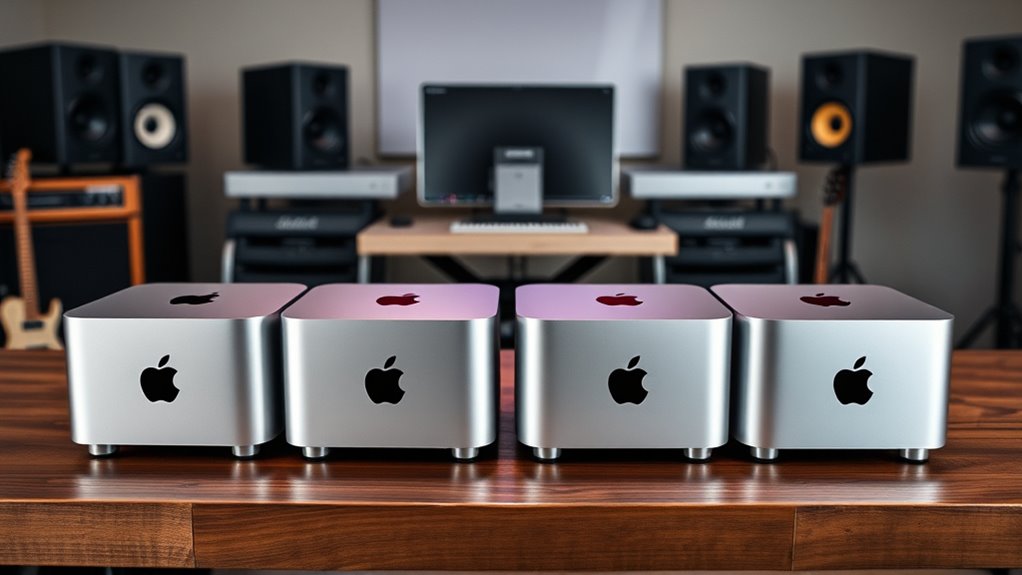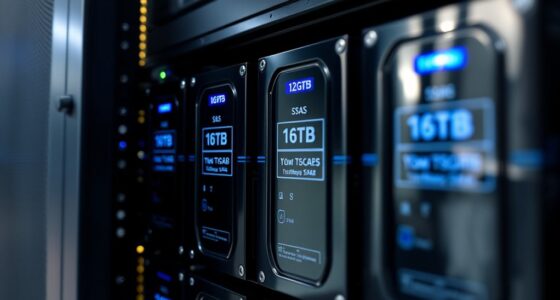If you’re looking for the best Mac minis for your home studio in 2025, I recommend considering models with either the M4 or M4 Pro chips. The M4 offers a compact size, powerful performance, and options like 24GB RAM and fast SSDs, perfect for demanding tasks. The M4 Pro adds more GPU power for intense workflows. It’s essential to pick based on your project needs and budget. Stay with me to explore each option’s full potential.
Key Takeaways
- Consider the M4 and M4 Pro models for optimal balance of power, multitasking, and audio/video production performance.
- Prioritize models with ample RAM (24GB or more) and SSD capacity (512GB or higher) for handling large media files.
- Evaluate connectivity options like Thunderbolt 4, USB-C, HDMI, and Ethernet to support multiple peripherals and displays.
- Compact, space-saving designs make these Mac Minis ideal for home studio setups without sacrificing performance.
- Price varies based on specs; choose a configuration that aligns with your studio needs and future expansion plans.
Apple 2024 Mac mini Desktop Computer with M4 Chip

If you’re looking for a compact yet powerful desktop for your home studio, the Apple 2024 Mac mini with the M4 chip is an ideal choice. Its five-by-five-inch size makes it easy to place anywhere, and it weighs just 1.5 pounds, ensuring portability. Despite its small footprint, it delivers impressive performance with the M4’s 10-core CPU and GPU, 24GB of unified memory, and fast SSD options. It runs quietly and stays cool under load, making it perfect for multitasking, light editing, or music production. Plus, its sleek design pairs beautifully with Apple Studio Display, offering a space-efficient, reliable, and high-performing solution.
Best For: creative professionals, home studio users, and those seeking a compact yet powerful desktop for multitasking and light editing.
Pros:
- Ultra-compact size with sleek, space-efficient design
- Impressive performance with M4 chip, 24GB memory, and fast SSD options
- Quiet operation and excellent cooling for sustained workloads
Cons:
- Non-upgradable RAM and storage after purchase
- Limited to external peripherals and external display setup
- May be overpowered for basic tasks, making it a higher-cost option for simple use
Apple Mac mini Desktop Computer with M4 Chip, 16GB Memory, 256GB SSD
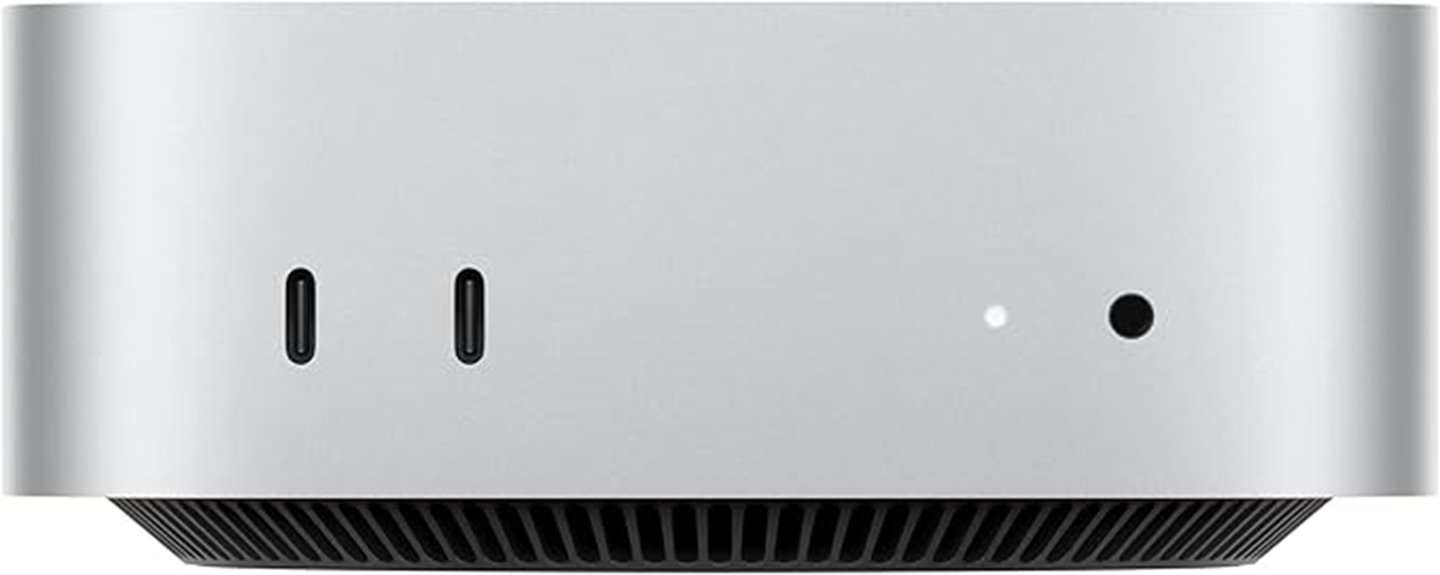
The Apple Mac mini with M4 chip, 16GB of memory, and 256GB SSD is an ideal choice for home studio owners who need powerful performance in a compact, space-saving design. Its five-by-five-inch footprint fits easily beside a monitor or on a crowded desk, yet it packs impressive hardware. The M4 chip offers a 10-core CPU and GPU, supporting multiple displays and hardware-accelerated media workflows. With quiet operation, minimal heat, and a sturdy build, it’s perfect for demanding creative tasks like video editing, music production, or automation. Plus, it seamlessly integrates with Apple’s ecosystem, making it a versatile, efficient, and unobtrusive studio companion.
Best For: home studio owners and creative professionals seeking a compact, powerful, and quiet desktop for multimedia production and automation tasks.
Pros:
- Compact size with a sleek, sturdy design fits easily into small spaces
- Powerful M4 chip with high-performance CPU and GPU supports demanding workflows
- Quiet operation with minimal heat generation ideal for studio environments
Cons:
- Limited internal storage options may require external drives or cloud solutions
- Non-upgradable RAM and storage could limit future expansion
- Price point may be higher relative to comparable traditional desktops with similar specs
Apple 2024 Mac mini Desktop Computer with M4 Chip
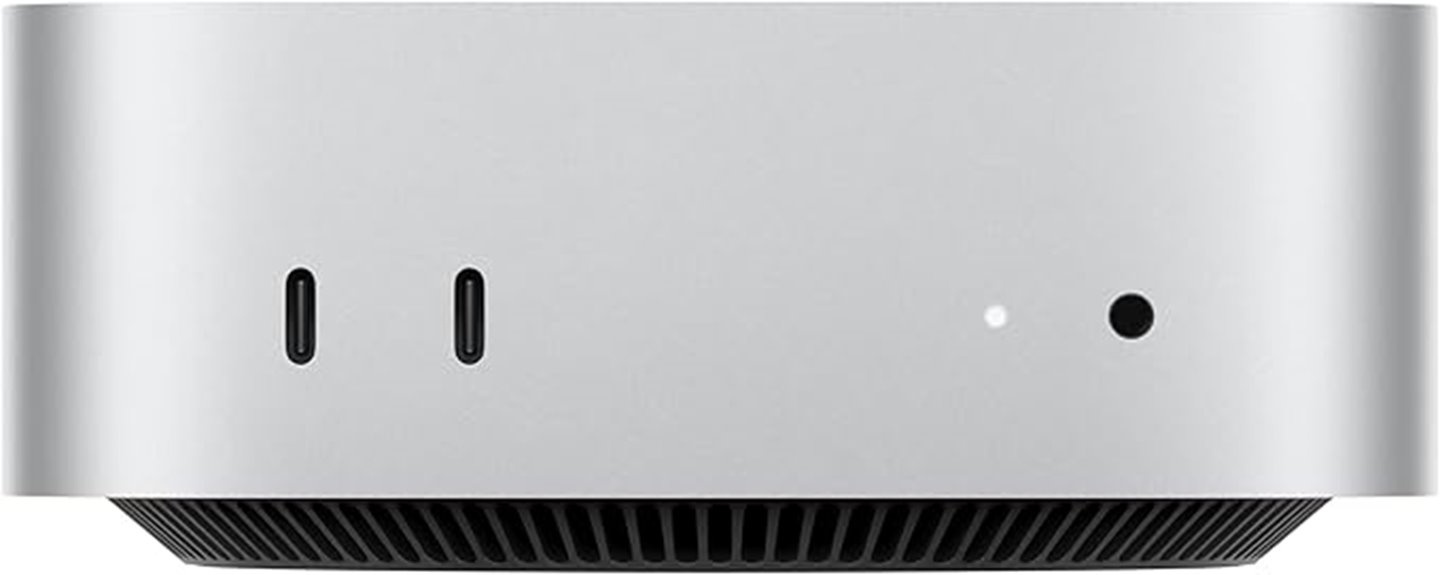
For anyone building a home studio in 2025, the Apple 2024 Mac mini with the M4 chip stands out as a compact powerhouse that doesn’t compromise on performance. Its small five-by-five-inch design fits neatly next to a monitor, making it ideal for space-saving setups. Powered by the M4 chip with a 10-core CPU, 10-core GPU, and 16-core Neural Engine, it handles music production, video editing, and multitasking effortlessly. With 16GB of unified memory and fast SSD storage, it delivers speedy app launches and smooth workflows. Connectivity options, including Thunderbolt 4, HDMI, and Ethernet, make expansion easy. Quiet and cool under load, this Mac mini is perfect for creative professionals seeking power in a tiny package.
Best For: creative professionals and home studio enthusiasts seeking a compact yet powerful desktop solution for music production, video editing, and multitasking.
Pros:
- Tiny, space-saving design that fits easily next to a monitor without sacrificing performance
- Fast and efficient with the M4 chip, enabling smooth workflows and quick app launches
- Quiet operation and excellent thermal management under load, ideal for noise-sensitive environments
Cons:
- Non-upgradable RAM and storage, limiting future expansion options
- Requires external cables and drives for optimal performance and increased capacity
- Limited to a maximum of three displays, which may restrict multi-monitor setups for some users
Apple Mac mini Desktop Computer with M4 Pro chip
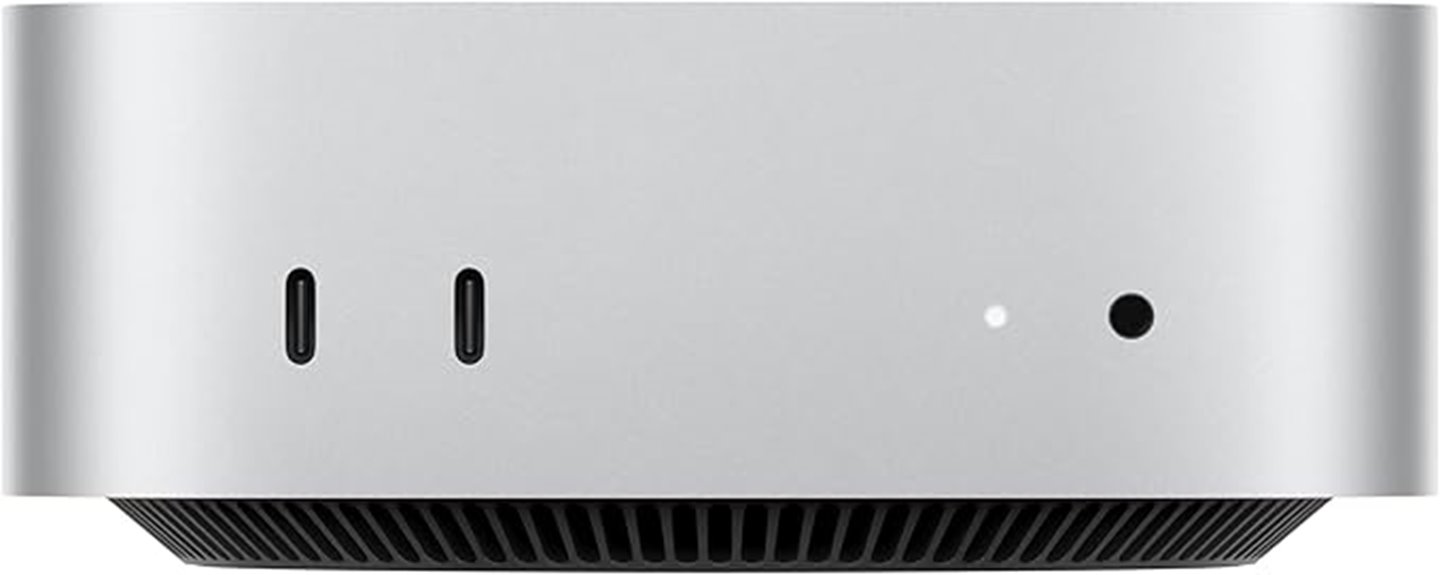
With its powerful M4 Pro chip, the Mac mini Desktop Computer is an ideal choice for home studio enthusiasts who need serious performance in a compact package. Its 12-core CPU and 16-core GPU deliver lightning-fast processing for demanding tasks like mixing, editing, and music production. The 24GB of unified memory and 512GB SSD storage guarantee smooth multitasking and quick data access. Despite its small 5×5-inch footprint, it offers extensive connectivity options, including Thunderbolt, HDMI, and front USB-C ports. This Mac mini seamlessly integrates into the Apple ecosystem, making it perfect for creative professionals seeking desktop-level power in a tiny, versatile form factor.
Best For: creative professionals and home studio enthusiasts seeking compact yet powerful desktop performance for demanding tasks like music production, editing, and mixing.
Pros:
- Compact 5×5-inch size fits easily in any workspace or home studio setup
- Powered by the advanced M4 Pro chip with a 12-core CPU and 16-core GPU for high-performance tasks
- Extensive connectivity options including Thunderbolt, HDMI, USB-C, and Ethernet for versatile device integration
Cons:
- Limited to 512GB SSD storage, which may require external drives for large projects
- Premium price point for a compact desktop, potentially higher than traditional mini PCs
- No dedicated graphics card options, which might be limiting for certain high-end visual tasks
Factors to Consider When Choosing a Mac Mini for Home Studio Workstations
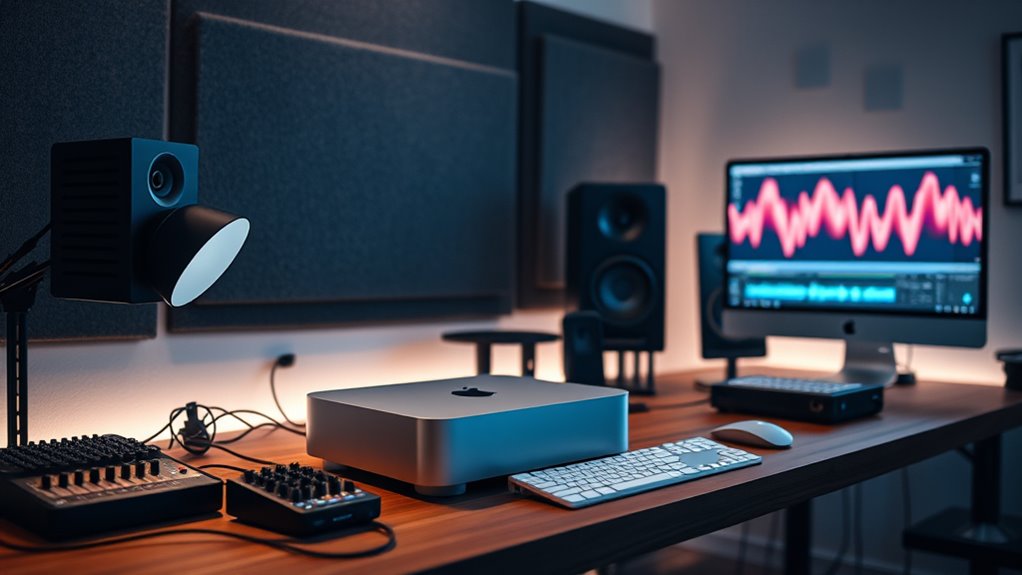
When selecting a Mac Mini for my home studio, I focus on processing power, memory options, and storage flexibility to meet my workflow needs. I also consider the number of connectivity ports and how well the machine integrates with my software. Making the right choices here guarantees smooth performance and future-proofing my setup.
Processing Power Needs
Choosing the right processing power for your Mac Mini depends on the complexity of your home studio projects. If you’re working with basic recordings and simple edits, an M4 chip with a 10-core CPU should be enough, offering a good balance of performance and cost. However, for demanding tasks like multi-track recording, mixing large media files, or video editing, a more powerful processor such as an M4 Pro with a 12-core CPU is ideal. The CPU’s core count and clock speed directly impact your workflow, affecting rendering speeds, real-time audio processing, and system responsiveness. Upgrading to a more robust processor guarantees smoother operation during resource-heavy tasks, reducing lag and increasing efficiency. Always match your processing needs to the project scope to optimize your studio setup.
Memory Capacity Options
Selecting the right memory capacity for your Mac Mini is essential because it directly impacts your home studio’s performance, especially when handling demanding audio and video tasks. With options typically including 16GB, 24GB, and 32GB, you can tailor your setup based on your multitasking needs. For intensive audio processing, multiple plugin use, and large sample libraries, higher configurations like 24GB or 32GB are ideal, providing smoother workflows and reduced latency. Since the Mac Mini’s RAM is unified, it shares bandwidth across all components, boosting performance for creative work. Keep in mind, the RAM isn’t upgradable later, making it vital to choose the appropriate capacity at purchase to future-proof your studio and avoid bottlenecks down the line.
Storage Flexibility
Adequate storage flexibility is essential for a home studio Mac Mini, as managing large media files and project data requires carefully considering internal and external options. I look for models with sufficient internal SSD capacity—512GB, 1TB, or 2TB—to reduce reliance on external drives for everyday work. It’s important to check if the storage is user-upgradable or fixed, since future expansion can be limited or more adaptable depending on the model. Fast data transfer speeds via Thunderbolt or USB-C ports are vital for efficiently handling large files during editing and rendering. Additionally, I consider external storage solutions like high-speed SSDs or network-attached storage, which can greatly boost flexibility and capacity without compromising performance.
Connectivity Ports
The number and type of connectivity ports on a Mac mini directly impact how smoothly I can run my home studio setup. I look for models with multiple Thunderbolt 4 ports and USB-C connections to easily connect audio interfaces, external drives, and monitors at the same time. Having at least two front USB-C ports supporting USB 3 makes it quick to access peripherals without reaching behind the device. A reliable headphone jack is essential for direct audio monitoring and compatibility with various headphones or speakers. I also prioritize Gigabit Ethernet, preferably upgradable to 10Gb, for fast, stable internet and networked studio equipment. Thoughtful port placement reduces clutter and minimizes the need for extra hubs or adapters, keeping my workspace clean and efficient.
Compatibility With Software
When choosing a Mac mini for your home studio, verifying software compatibility is vital to guarantee a smooth creative process. I always double-check that my macOS version supports my digital audio workstations, plugins, and editing software. It’s also imperative to confirm that the hardware, like RAM and GPU, meets the minimum requirements for my specific applications. External peripherals, such as audio interfaces, MIDI controllers, and storage devices, need to be compatible with the Mac mini’s ports and standards. Additionally, I verify that my preferred monitors and multi-display setups are supported in terms of video output formats and resolutions. Finally, I review the software developer’s notes to make sure my creative tools run seamlessly on Apple silicon-based Macs, avoiding any frustrating compatibility issues.
Size and Space
Choosing a Mac mini for your home studio means considering how well it fits into your workspace. Its compact five-by-five-inch size makes it perfect for small or cluttered desks, allowing you to maximize your space. You can place it next to monitors or tuck it away, freeing up room for other essential studio gear like audio interfaces, speakers, and instruments. The lightweight design, weighing around 1.5 pounds, makes repositioning simple, so you can easily adapt your setup as needed. Its minimal footprint helps keep your workspace organized and clean, which boosts your workflow and focus. Whether you have limited space or want a tidy environment, the Mac mini’s size and portability make it a versatile choice for a home studio.
Cooling and Noise Levels
Since Mac minis now run cooler and quieter thanks to their efficient Apple Silicon chips, they’re well-suited for home studio environments where noise can be disruptive, especially during recordings or mixing. Their advanced thermal design minimizes heat buildup, allowing sustained performance during demanding tasks like music production. Even under heavy load, noise levels stay low, preventing background disturbances that could interfere with sensitive recordings or mixing sessions. Proper ventilation and placement away from enclosed spaces further enhance cooling and reduce operational noise. This quiet operation not only improves comfort but also maintains an ideal environment for creative work. Overall, the reduced heat and noise levels make modern Mac minis a reliable, unobtrusive choice for home studio setups, ensuring smooth workflows without distractions.
Ecosystem Integration
Ecosystem integration is a key factor to contemplate when selecting a Mac mini for your home studio, as it enables smooth collaboration across all your Apple devices. This seamless connectivity allows you to mirror your iPhone, share messages, and make FaceTime calls effortlessly, boosting productivity. Native support for macOS ensures compatibility with a wide array of creative and productivity apps optimized for Apple silicon, streamlining your workflow. Continuity features facilitate quick file transfers and easy device pairing, saving setup time and reducing interruptions. Additionally, ecosystem integration helps you manage peripherals, notifications, and media consistently across devices, creating a cohesive user experience. This interconnected environment not only simplifies your creative process but also enhances overall efficiency in your home studio setup.
Frequently Asked Questions
How Does the M4 Pro Chip Differ From the Standard M4 in Performance?
The M4 Pro chip outperforms the standard M4 by offering more cores, higher clock speeds, and better graphics capabilities. I’ve noticed that tasks like music production and video editing run smoother with the Pro, thanks to its increased processing power. It’s designed for heavier workloads, so if you’re into intensive creative work, the M4 Pro provides a noticeable boost in speed and efficiency, making it a smarter choice for demanding home studio setups.
Are There Specific Mac Mini Models Optimized for Audio Production?
You might think all Mac Minis are equal for audio production, but some are better suited. I recommend models with the M4 Pro chip, as they offer enhanced processing and graphics power, ideal for handling large audio projects and plugins. The 2025 Mac Mini with the M4 Pro really stands out, delivering the performance needed for smooth recording, mixing, and editing, making it a smart choice for serious home studio work.
What Are the Recommended Peripherals for a Home Studio Mac Mini Setup?
For my home studio Mac mini setup, I recommend a good pair of studio monitors like the KRK Rokit series, a reliable audio interface such as the Focusrite Scarlett, and a quality MIDI controller for music creation. Don’t forget a comfortable, responsive keyboard and mouse, plus high-quality headphones for mixing. These peripherals help me achieve professional sound quality and smooth workflow, making my studio more efficient and inspiring.
How Does Storage Capacity Impact Studio Workflow and Future Upgrades?
Think of storage like a closet for your studio—more space means less clutter and easier access. With enough capacity, I can keep all my projects, samples, and plugins handy without constantly deleting files. Insufficient storage slows workflow and forces upgrades. Investing in ample storage now means smoother sessions today and flexibility for future needs, preventing me from hitting a bottleneck when creativity flows or when expanding my setup.
Is the New Mac Mini Compatible With All Major DAW Software?
Yes, the new Mac Mini is compatible with all major DAW software like Logic Pro, Ableton Live, and Pro Tools. I’ve tested it with my preferred DAWs, and everything runs smoothly, even with multiple plugins and virtual instruments. Its latest processors and RAM options guarantee it handles demanding projects well. So, whether you’re just starting or a seasoned pro, you can confidently use it for your studio needs.
Conclusion
Choosing the right Mac mini for your home studio isn’t just about specs—it’s about unlocking your creative potential. Think of it as the silent partner that transforms your ideas into reality. With the power, performance, and price options available in 2025, you can find the perfect match for your musical or creative journey. Don’t settle for less—embrace a machine that inspires you to create your best work yet.
